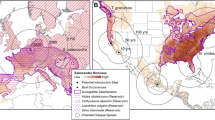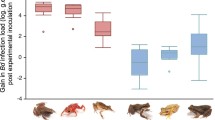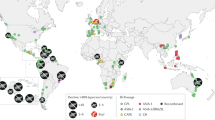Abstract
The human-mediated transport of infected amphibians is the most plausible driver for the intercontinental spread of chytridiomycosis, a recently emerged infectious disease responsible for amphibian population declines and extinctions on multiple continents. Chytridiomycosis is now globally ubiquitous, and it cannot be eradicated from affected sites. Its rapid spread both within and between continents provides a valuable lesson on preventing future panzootics and subsequent erosion of biodiversity, not only of amphibians, but of a wide array of taxa: the continued inter-continental trade and transport of animals will inevitably lead to the spread of novel pathogens, followed by numerous extinctions. Herein, we define and discuss three levels of amphibian disease management: (1) post-exposure prophylactic measures that are curative in nature and applicable only in a small number of situations; (2) pre-exposure prophylactic measures that reduce disease threat in the short-term; and (3) preventive measures that remove the threat altogether. Preventive measures include a virtually complete ban on all unnecessary long-distance trade and transport of amphibians, and are the only method of protecting amphibians from disease-induced declines and extinctions over the long-term. Legislation to prevent the emergence of new diseases is urgently required to protect global amphibian biodiversity.

Similar content being viewed by others
References
Aplin K, Kirkpatrick P (1999) Progress Report on Investigations into Chytrid Fungal Outbreak in Western Australia, Perth, Australia: Western Australia Museum.
Berger L, Marantelli G, Skeratt LF, Speare R (2005) Virulence of the amphibian chytrid fungus Batrachochytrium dendrobatidis varies with the strain. Diseases of Aquatic Organisms 68:47–50.
Berger L, Speare R, Daszak P, Green DE, Cunningham AA, Goggin CL, et al. (1998) Chytridiomycosis causes amphibian mortality associated with population declines in the rain forests of Australia and Central America. Proceedings of the National Academy of Sciences of the United States of America 95:9031–9036
Bosch J, Martínez-Solano I, García-París M (2001) Evidence of a chytrid fungus infection involved in the decline of the common midwife toad (Alytes obstetricans) in protected areas of central Spain. Biological Conservation 97:331–337.
DEH (2005) Threat Abatement Plan for Infection of Amphibians with Chytrid Fungus Resulting in Chytridiomycosis, Canberra, Australia: Department of Environment and Heritage.
Duellman WE (1999) Patterns of Distribution of Amphibians: A Global Perspective, Baltimore: The Johns Hopkins University Press.
Fisher MC, Garner TWJ (2007) The relationship between the emergence of Batrachochytrium dendrobatidis, the international trade in amphibians and introduced amphibian species. Fungal Biology Reviews 21:2–9.
Garner TWJ, Perkins MW, Govindarajulu P, Seglie D, Walker S, Cunningham AA, et al. (2006) The emerging pathogen Batrachochytrium dendrobatidis globally infects introduced populations of the North American bullfrog, Rana catesbeiana. Biology Letters 2:455–459.
Garner TWJ, Walker S, Bosch J, Hyatt AD, Cunningham AA, Fisher MC (2005) Chytrid fungus in Europe. Emerging Infectious Diseases 11:1639–1641.
Gascon C, Collins JP, Moore RD, Church DR, McKay JE, Mendelson JR III (editors) (2007) Amphibian Conservation Action Plan, Gland, Switzerland and Cambridge, UK: IUCN/SSC Amphibian Specialist Group, 64 pp
Goldberg TL, Readel AM, Lee MH (2007) Chytrid fungus in frogs from an equatorial African montane forest in western Uganda. Journal of Wildlife Diseases 43:521–524.
Hyatt AD, Boyle DG, Olsen V, Boyle DB, Berger L, Obendorf D, et al. (2007) Diagnostic assays and sampling protocols for the detection of Batrachochytrium dendrobatidis. Diseases of Aquatic Organisms 73:175–192.
Kraaijeveld-Smit FJL, Griffiths RA, Moore RD, Beebee TJC (2006) Captive breeding and the fitness of reintroduced species: a test of the responses to predators in a threatened amphibian. Journal of Applied Ecology 43:360–365
Kriger KM, Hero J-M (2006) Survivorship in wild frogs infected with chytridiomycosis. EcoHealth 3:171–177.
Kriger KM, Hero J-M (2008) Altitudinal distribution of chytrid (Batrachochytrium dendrobatidis) infection in subtropical Australian frogs. Austral Ecology 33(8):1022–1032
Kriger KM, Pereoglou F, Hero J-M (2007) Latitudinal variation in the prevalence and intensity of chytrid (Batrachochytrium dendrobatidis) infection in eastern Australia. Conservation Biology 21:1280–1290.
Lee S, Zippel K, Ramos L, Searle J (2006) Captive-breeding programme for the Kihansi spray toad Nectophrynoides asperginis at the Wildlife Conservation Society, Bronx, New York. International Zoo Yearbook 40:241–253.
Li YM, Wilcove DS (2005) Threats to vertebrate species in China and the United States. Bioscience 55:147–153.
Lips KR, Brem F, Brenes R, Reeve JD, Alford RA, Voyles J, et al. (2006) Emerging infectious disease and the loss of biodiversity in a neotropical amphibian community. Proceedings of the National Academy of Sciences of the United States of America 103:3165–3170
Lips KR, Diffendorfer J, Mendelson JR III, Sears MW (2008) Riding the wave: reconciling the roles of disease and climate change in amphibian declines. PLoS Biology 6:441–454.
Mazzoni R, Cunningham AC, Daszak P, Apolo A, Perdomo E, Speranza G (2003) Emerging pathogen of wild amphibians in frogs (Rana catesbiana) farmed for international trade. Emerging Infectious Diseases 9:995–998.
McDonald KR, Mendez D, Muller R, Freeman AB, Speare R (2005) Decline in the prevalence of chytridiomycosis in frog populations in North Queensland, Australia. Pacific Conservation Biology 11:114–120.
Ouellet M, Mikaelian I, Pauli BD, Rodrigue J, Green DM (2005) Historical evidence for widespread chytrid infection in North American amphibian populations. Conservation Biology 19:1431–1440.
Parker JM, Mikaelian I, Hahn N, Diggs HE (2002) Clinical diagnosis and treatment of epidermal chytridiomycosis in African clawed frogs (Xenopus tropicalis). Comparative Medicine 52:265–268.
Pearl CA, Bull EL, Green DE, Bowerman J, Adams MJ, Hyatt A, et al. (2007) Occurrence of the amphibian pathogen Batrachochytrium dendrobatidis in the Pacific Northwest. Journal of Herpetology 41:145–149.
Pessier AP, Nichols DK, Longcore JE, Fuller MS (1999) Cutaneous chytridiomycosis in poison dart frogs (Dendrobates spp.) and White’s tree frog (Litoria caerulea). Journal of Veterinary Diagnostic Investigation 11:194–199.
Puschendorf R, Bolanos F, Chaves G (2006) The amphibian chytrid fungus along an altitudinal transect before the first reported declines in Costa Rica. Biological Conservation 132:136–142.
Rachowicz LJ, Knapp RA, Morgan JAT, Stice MJ, Vredenburg VT, Parker JM, et al. (2006) Emerging infectious disease as a proximate cause of amphibian mass mortality. Ecology 87:1671–1683.
Retallick R, McCallum H, Speare R (2004) Endemic infection of the amphibian chytrid fungus in a frog community post-decline. PLoS Biology 2:1–7.
Ron SR (2005) Predicting the distribution of the amphibian pathogen Batrachochytrium dendrobatidis in the new world. Biotropica 37:209–221.
Schlaepfer MA, Hoover C, Dodd CK Jr (2005) Challenges in evaluating the impact of the trade in amphibians and reptiles on wild populations. Bioscience 55:256–264.
Seimon TA, Seimon A, Daszak P, Halloy SRP, Schloegel LM, Aguilar CA, et al. (2007) Upward range extension of Andean anurans and chytridiomycosis to extreme elevations in response to tropical deglaciation. Global Change Biology 13:288–299.
Skerratt LF, Berger L, Speare R, Cashins S, McDonald KR, Phillott AD, et al. (2007) Spread of chytridiomycosis has caused the rapid global decline and extinction of frogs. EcoHealth 4:125–134.
Stuart SN, Chanson JS, Cox NA, Young BE, Rodrigues ASL, Fischman DL, et al. (2004) Status and trends of amphibian declines and extinctions worldwide. Science 306:1783–1786.
Tyler MJ, Wassersug R, Smith B (2007) How frogs and humans interact: influences beyond habitat destruction, epidemics and global warming. Applied Herpetology 4:1–18.
Weldon C, du Preez LH, Muller R, Hyatt AD, Speare R (2004) Origin of the amphibian chytrid fungus. Emerging Infectious Diseases 10:2100–2105.
Woodhams DC, Alford RA (2005) Ecology of chytridiomycosis in rainforest stream frog assemblages of tropical Queensland. Conservation Biology 19:1449–1459.
Woodhams DC, Alford RA, Marantelli G (2003) Emerging disease of amphibians cured by elevated body temperature. Diseases of Aquatic Organisms 55:65–67.
Young S, Berger L, Speare R (2007) Amphibian chytridiomycosis: strategies for captive management and conservation. International Zoo Yearbook 41:1–11.
Acknowledgments
We thank Jeremy Thompson, Monique Van Sluys, and two anonymous reviewers for comments that greatly improved the quality of the final manuscript. Financial support for this work was graciously provided by the Eppley Foundation for Research.
Author information
Authors and Affiliations
Corresponding author
Electronic supplementary material
Below is the link to the electronic supplementary material.
Rights and permissions
About this article
Cite this article
Kriger, K.M., Hero, JM. Chytridiomycosis, Amphibian Extinctions, and Lessons for the Prevention of Future Panzootics. EcoHealth 6, 6–10 (2009). https://doi.org/10.1007/s10393-009-0228-y
Received:
Revised:
Accepted:
Published:
Issue Date:
DOI: https://doi.org/10.1007/s10393-009-0228-y




